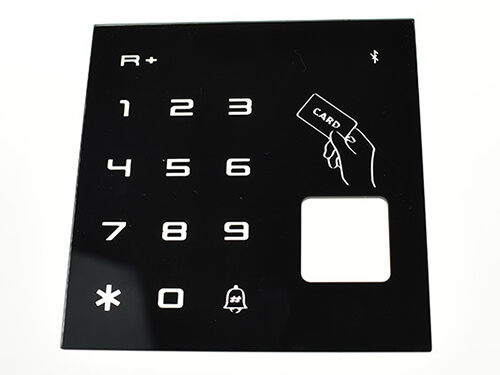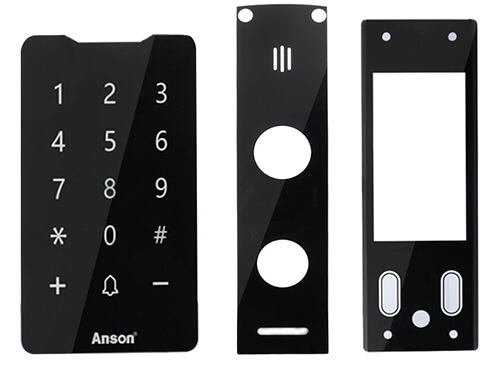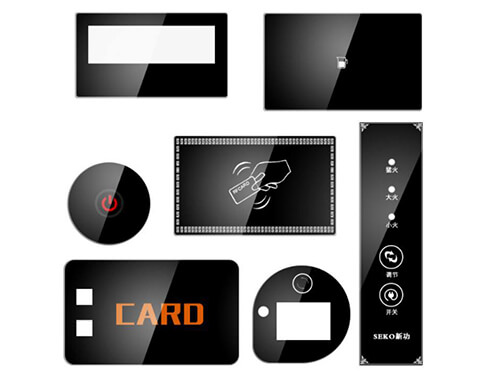Glass Tempering Service
OEM custom glass parts tempering service at good price
Contact us now to request a quick quote.
What is glass tempering service?
Glass tempering service refers to the process of heat treating glass to increase its strength and resistance to mechanical and thermal stress. Tempered glass is also known as safety glass because of its unique properties and enhanced safety features.
The tempering process involves heating the glass to a high temperature and then rapidly cooling it using jets of cold air.
This rapid cooling creates a state of high surface compression on the outer layers of the glass, while the inner core remains in tension.
As a result, tempered glass is much stronger and more resistant to impact and thermal stress compared to untreated glass.

What are the properties of glass tempering?
Glass tempering is a process used to enhance the strength and safety of glass by subjecting it to controlled heating and rapid cooling. The main properties of glass tempering include:
Increased Strength
Tempered glass is significantly stronger than regular annealed glass. It can withstand higher impact forces and bending without breaking. Tempered glass is typically 4 to 5 times stronger than annealed glass of the same thickness.
Safety
When tempered glass does break, it shatters into small, relatively harmless pieces known as "dice" or "cubes" instead of sharp, jagged shards. This reduces the risk of injury and makes tempered glass safer for use in areas where human impact is a concern.
Thermal Resistance
Tempered glass has higher thermal resistance compared to annealed glass. It can withstand rapid temperature changes without cracking or breaking due to its improved thermal shock resistance.
Uniform Stress Distribution
During the tempering process, the outer surfaces of the glass are put into compression while the inner core is in tension. This creates a state of balanced internal stresses, resulting in a more uniform distribution of stress throughout the glass. As a result, tempered glass can handle localized stress better, making it less prone to cracking or breaking under pressure.
Scratch Resistance
The tempering process also improves the hardness of glass, making it more resistant to scratches and abrasions. This property is particularly beneficial in applications where the glass is exposed to regular contact or friction.
Heat Resistance
Tempered glass has better resistance to thermal stress caused by sunlight or heat sources compared to annealed glass. It can withstand higher temperatures without cracking or undergoing significant deformation.
It’s important to note that tempered glass cannot be cut or modified after the tempering process. Any attempts to alter the glass’s shape or size will cause it to shatter into small pieces. Therefore, it must be cut and shaped to the desired dimensions before undergoing the tempering process.

Types of glass tempering?
There are mainly two types of glass tempering processes:
Thermal Tempering
Thermal tempering, also known as heat tempering, is the most common method of tempering glass. In this process, the glass is first cut and shaped to the desired dimensions. It is then heated to a high temperature (around 620 to 650 degrees Celsius or 1150 to 1200 degrees Fahrenheit) in a tempering furnace. The glass is heated uniformly and quickly using radiant heaters or convection heating methods. After reaching the desired temperature, the glass is rapidly cooled by blasts of air, causing the surfaces to cool and solidify faster than the core. This rapid cooling creates a state of high compressive stress on the outer surfaces while the core remains in tension, resulting in tempered glass with enhanced strength and safety properties.
Chemical Tempering
Chemical tempering, also known as chemical strengthening, is an alternative method to thermal tempering. In this process, the glass is soaked in a bath of molten salt, typically potassium nitrate (KNO3), at a temperature close to the glass's softening point. The glass surface undergoes an ion exchange process where the smaller sodium ions in the glass are replaced by larger potassium ions from the molten salt bath. This ion exchange creates compressive stress on the surface, making the glass stronger and more resistant to breaking. Chemical tempering is often used for specialized applications where extremely high strength is required, such as for thin glass used in electronic displays.

What are the benefits of glass tempering?
Glass tempering enhances the performance, safety, and longevity of glass, making it an ideal choice for applications where strength, safety, and durability are paramount. Glass tempering offers several benefits that make it a preferred choice for various applications. Here are the key advantages of glass tempering:
Increased Strength
Tempered glass is approximately four to five times stronger than regular annealed glass of the same thickness. It can withstand higher levels of impact and is less prone to breaking or shattering when subjected to external forces.
Safety
One of the main advantages of tempered glass is its safety features. When tempered glass breaks, it shatters into small, relatively harmless pieces with rounded edges instead of sharp, jagged shards like regular glass. This reduces the risk of injury in case of breakage, making tempered glass a preferred choice in applications where safety is crucial.
Durability
Tempered glass is more resistant to scratches, abrasions, and other forms of wear and tear due to its increased hardness. It maintains its clarity and visual appeal over time, making it a durable choice for various applications.
Design Flexibility
Tempered glass can be customized and fabricated into various shapes, sizes, and thicknesses before undergoing the tempering process. This allows for greater design flexibility and enables its use in a wide range of architectural, automotive, and industrial applications.
Wide Range of Applications
Tempered glass is used in various applications where safety, strength, and durability are important. It is commonly used in architectural applications such as windows, doors, shower enclosures, and glass facades. It is also used in automotive windows, furniture, display cases, appliances, and other areas where safety and durability are essential.
Thermal Resistance
Tempered glass has superior thermal resistance compared to regular glass. It can withstand high-temperature differentials, such as exposure to direct sunlight or rapid heating and cooling, without cracking or breaking. This property makes tempered glass suitable for applications where thermal stress is a concern, such as windows, doors, and glass panels in buildings.
Scratch Resistance
Tempered glass is more resistant to scratches and surface damage compared to regular glass. The tempering process creates a hardened surface that is less prone to scratches and marks from everyday use or cleaning.

Custom Tempered Glass Parts We Can Manufacture
- Frosted Glass Lens
- Round Sight Glass
- Touch Switches
- Touch Glass
- Glass Touch Panel
- Display Glass
- Tempered Glass Panel
- Smart Switch
- Circular Sight Glass
- Sight Glass Window
- Solar Panel Glass
- Electrical Glass
- Flashlight Glass Lens
- Silk Printing Glass Panel
- Anti-Glare Glass Lens
- High Transparent Lens
- Monitoring Lenses
- Optical Instruments
- Industrial Sight Glass
- Switch Panel Glass
- Sapphire Glass Lens
- Sapphire Window
- Quartz Glass Sight Glass
- Heat-insulating Glass
Why More Than 1500+ Clients ♥️ HY
Save Cost
We will reduce your 40%-80% purchase cost by investing in high-quality glass machining machines, improving production efficiency, and purchasing raw materials in bulk.
Ultra Quality
Our QC department combines the most advanced technology and experienced professionals to ensure strict inspection and 100% compliance with your requirements and specifications.
Precision Machining
Our tolerances are between +/-0.05~0.1 (mm) to meet your accuracy requirements for the custom glass parts. Our ultra-modern machining technology can meet your tight request for custom-cutting glass parts.
Expertise Engineer Team
Our full-experience engineering team provides technical consultation, pre-review of drawings, structural analysis, risk assessment, design suggestions, and cost analysis to ensure accuracy and save the cost for you.
Fast Delivery
Samples time can be as fast as 3 business days. Mass production time can be as fast as 5 business days. Our advanced equipment and streamlined production process will meet your urgent time request.
No MOQ
You won't face MOQ problems with us. We never require a minimum order volume or minimum dollar value. We'll help you to achieve your goal even if you only need 1 pc custom glass cut part.
Get Your Custom Tempered Glass Parts Into Production Today
Want to save time and money on your custom tempered glass parts project? Contact us now. Our factory provides high-quality precision custom tempered glass parts at very competitive prices and fast production times. We support free sample service.